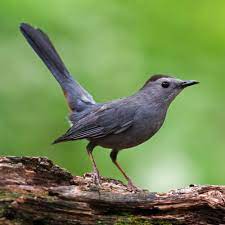
I have two catbirds that visit me when I go out on the patio with a bowl of wiggly meal worms. One is the Moocher and the other is the Mother. Though both birds are identical in appearance, I can easily tell the mother bird. When I toss a few meal worms her way, she puts each one carefully in her beak (her best score is 10 mealworms in one mouthful) then flies around the side of the house and across the street to feed her chicks. I don’t know how she knows I am in the backyard, since she’s in a nest across the road, but she knows and always pays me a visit. The other catbird, Mr. Moocher, is in it for himself. He gobbles up every worm right on the spot. I can’t tell which bird is which until I see their eating habits. I have tried not feeding the Moocher, but he is persistent to a fault. He meows like a hungry cat, and hops from the chair to a table to a nearby bush – begging.
Catbirds are secretive but energetic, hopping and fluttering from branch to branch through tangles of vegetation. Singing males sit atop shrubs and small trees. Catbirds are reluctant to fly across open areas, preferring quick, low flights over vegetation. They are also pretty birds. At first glance, they appear to be entirely slate gray, but with a closer look you’ll see a small black cap, blackish tail, and a rich rufous-brown patch under the tail.
So, I feed both birds. Who knows? Maybe next spring, the Moocher will become the Mother, or even the Daddy Catbird and I always have plenty of meal worms to go around.

